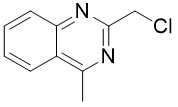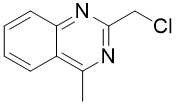
109113-72-6 2-(Chloromethyl)-4-Methylquinazoline C10H9ClN2 1308068-626-2
-
High Light
109113-72-6 Pharmaceutical Intermediates
,C10H9ClN2 Pharmaceutical Intermediates
,2 Chloromethyl 4 Methylquinazoline
-
Product Name2-(chloromethyl)-4-methylquinazoline
-
Synonyms2-(chloromethyl)-4-methylquinazoline;Quinazoline,2-(chloroMethyl)-4-Methyl-;Linagliptin InterMediate A;2-chloroMethyl-4-Methyl Quinaoline;Linagliptin INT3;109113-72-6;Linaint-I;2-(chloromethyl)-4-methylquizoline
-
CAS109113-72-6
-
MFC10H9ClN2
-
MW192.64
-
EINECS1308068-626-2
-
Melting Point61.0 To 65.0 °C
-
Density1.251
-
Chemical PropertiesWhite To Yellow Powder
-
Purity98%
-
Place of OriginChina
-
Brand NameRUN
-
CertificationIOS9001
-
Model NumberRUN-Z
-
Minimum Order Quantity10g
-
Priceinquiry
-
Packaging Details10g 50g 100g 500g 1kg
-
Delivery Time3-7 days
-
Payment TermsT/T, MoneyGram, BTCcoin
-
Supply Ability1kg --100kg
109113-72-6 2-(Chloromethyl)-4-Methylquinazoline C10H9ClN2 1308068-626-2
SECTION 1: Basic information
| 2-(chloromethyl)-4-methylquinazoline Basic information |
| Product Name: | 2-(chloromethyl)-4-methylquinazoline |
| Synonyms: | 2-(chloromethyl)-4-methylquinazoline;Quinazoline,2-(chloroMethyl)-4-Methyl-;Linagliptin interMediate A;2-chloroMethyl-4-Methyl quinaoline;Linagliptin INT3;109113-72-6;Linaint-I;2-(chloromethyl)-4-methylquizoline |
| CAS: | 109113-72-6 |
| MF: | C10H9ClN2 |
| MW: | 192.64 |
| EINECS: | 1308068-626-2 |
| Product Categories: | Intermediates |
| Mol File: | 109113-72-6.mol |
| 2-(chloromethyl)-4-methylquinazoline Chemical Properties |
| Melting point | 61.0 to 65.0 °C |
| Boiling point | 240.0±32.0 °C(Predicted) |
| density | 1.251 |
| pka | 1.86±0.50(Predicted) |
| λmax | 318nm(EtOH)(lit.) |
| InChIKey | UHCUBOJGMLASBY-UHFFFAOYSA-N |
| Safety Information |
| RIDADR | 3261 |
| HazardClass | 8 |
| PackingGroup | III |
SECTION 2: Hazard identification
2.1 Classification of the substance or mixture
Acute toxicity - Category 4, Oral
Skin irritation, Category 2
Skin sensitization, Category 1
Serious eye damage, Category 1
Hazardous to the aquatic environment, long-term (Chronic) - Category Chronic 1
2.2 GHS label elements, including precautionary statements
| Pictogram(s) | |
|---|---|
| Signal word | Warning |
| Hazard statement(s) |
H302 Harmful if swallowed H315 Causes skin irritation H317 May cause an allergic skin reaction H318 Causes serious eye damage H400 Very toxic to aquatic life H410 Very toxic to aquatic life with long lasting effects |
| Precautionary statement(s) | |
| Prevention |
P264 Wash ... thoroughly after handling. P270 Do not eat, drink or smoke when using this product. P280 Wear protective gloves/protective clothing/eye protection/face protection/hearing protection/... P261 Avoid breathing dust/fume/gas/mist/vapours/spray. P272 Contaminated work clothing should not be allowed out of the workplace. P273 Avoid release to the environment. |
| Response |
P301+P317 IF SWALLOWED: Get medical help. P330 Rinse mouth. P302+P352 IF ON SKIN: Wash with plenty of water/... P321 Specific treatment (see ... on this label). P332+P317 If skin irritation occurs: Get medical help. P362+P364 Take off contaminated clothing and wash it before reuse. P333+P317 If skin irritation or rash occurs: Get medical help. P305+P354+P338 IF IN EYES: Immediately rinse with water for several minutes. Remove contact lenses, if present and easy to do. Continue rinsing. P317 Get medical help. P391 Collect spillage. |
| Storage | none |
| Disposal | P501 Dispose of contents/container to an appropriate treatment and disposal facility in accordance with applicable laws and regulations, and product characteristics at time of disposal. |
2.3 Other hazards which do not result in classification
no data available
SECTION 3: Composition/information on ingredients
3.1 Substances
| Chemical name | Common names and synonyms | CAS number | EC number | Concentration |
|---|---|---|---|---|
| 2-(Chloromethyl)-4-methylquinazoline | 2-(Chloromethyl)-4-methylquinazoline | 109113-72-6 | - | 100% |
SECTION 4: First-aid measures
4.1 Description of necessary first-aid measures
If inhaled
Move the victim into fresh air. If breathing is difficult, give oxygen. If not breathing, give artificial respiration and consult a doctor immediately. Do not use mouth to mouth resuscitation if the victim ingested or inhaled the chemical.
Following skin contact
Take off contaminated clothing immediately. Wash off with soap and plenty of water. Consult a doctor.
Following eye contact
Rinse with pure water for at least 15 minutes. Consult a doctor.
Following ingestion
Rinse mouth with water. Do not induce vomiting. Never give anything by mouth to an unconscious person. Call a doctor or Poison Control Center immediately.
4.2 Most important symptoms/effects, acute and delayed
no data available
4.3 Indication of immediate medical attention and special treatment needed, if necessary
no data available
SECTION 5: Fire-fighting measures
5.1 Suitable extinguishing media
Use dry chemical, carbon dioxide or alcohol-resistant foam.
5.2 Specific hazards arising from the chemical
no data available
5.3 Special protective actions for fire-fighters
Wear self-contained breathing apparatus for firefighting if necessary.
SECTION 6: Accidental release measures
6.1 Personal precautions, protective equipment and emergency procedures
Avoid dust formation. Avoid breathing mist, gas or vapours.Avoid contacting with skin and eye. Use personal protective equipment.Wear chemical impermeable gloves. Ensure adequate ventilation.Remove all sources of ignition. Evacuate personnel to safe areas.Keep people away from and upwind of spill/leak.
6.2 Environmental precautions
Prevent further spillage or leakage if it is safe to do so. Do not let the chemical enter drains. Discharge into the environment must be avoided.
6.3 Methods and materials for containment and cleaning up
Collect and arrange disposal. Keep the chemical in suitable and closed containers for disposal. Remove all sources of ignition. Use spark-proof tools and explosion-proof equipment. Adhered or collected material should be promptly disposed of, in accordance with appropriate laws and regulations.
SECTION 7: Handling and storage
7.1 Precautions for safe handling
Handling in a well ventilated place. Wear suitable protective clothing. Avoid contact with skin and eyes. Avoid formation of dust and aerosols. Use non-sparking tools. Prevent fire caused by electrostatic discharge steam.
7.2 Conditions for safe storage, including any incompatibilities
Store the container tightly closed in a dry, cool and well-ventilated place. Store apart from foodstuff containers or incompatible materials.
SECTION 8: Exposure controls/personal protection
8.1 Control parameters
Occupational Exposure limit values
no data available
Biological limit values
no data available
8.2 Appropriate engineering controls
Ensure adequate ventilation. Handle in accordance with good industrial hygiene and safety practice. Set up emergency exits and the risk-elimination area.
8.3 Individual protection measures, such as personal protective equipment (PPE)
Eye/face protection
Wear tightly fitting safety goggles with side-shields conforming to EN 166(EU) or NIOSH (US).
Skin protection
Wear fire/flame resistant and impervious clothing. Handle with gloves. Gloves must be inspected prior to use. Wash and dry hands. The selected protective gloves have to satisfy the specifications of EU Directive 89/686/EEC and the standard EN 374 derived from it.
Respiratory protection
If the exposure limits are exceeded, irritation or other symptoms are experienced, use a full-face respirator.
Thermal hazards
no data available
